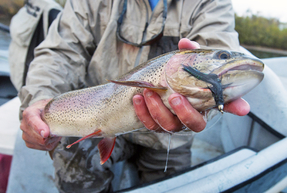
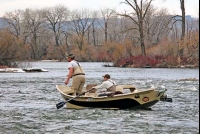
While there are some decent fishing days in December and January, the weather often isn’t up to my liking. It’s likely one of the things that go hand in hand with getting old. I’ve spent plenty of days breaking ice out of my guides but for the most part, those days are behind me. By the end of February and into March the daytime temperatures normally are above freezing bringing back the urge to get back on the water.
My favorite winter fishing is dry flies. Midge fishing can be great, especially if the weather is calm and overcast. If conditions aren’t right for dry fly fishing there is always the option to fish nymphs. However, when I consider the different ways to fish for trout I often turn to streamers, especially this time of year.
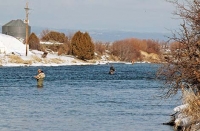
Some of the techniques and equipment to use are different than fishing streamers in the summer months. In the summer I frequently use a floating line and I like to give the fly plenty of action. No so in the winter months when the water is cold. Trout are cold blooded and even though the interest is there, they are a little slower on the draw with lower metabolism due to the colder water. That doesn’t mean they can’t get the job done but we need to consider this fact with the techniques and equipment we use.
First I’d like to consider equipment. I’m not a fan of heavy rods but for winter streamer fishing I like to move up a line size or two. I normally use a 9’0” #6 weight rod for summer streamer fishing. In the winter a #7 rod works better for me because I use a heavier lines or sinking leaders with weighted streamers. Remember, trout aren’t going to move as far when the water is cold so you need to get the fly down.
I don’t like using a full sinking line for streamer fishing. It’s important to be able to mend line to better control the swing or drift. For that reason I prefer a sink tip. My favorite is the Streamer Tip by Rio. It has a short 10’ type 6 sinking tip section which gets the fly down quickly. Another option that works well is to utilize the VersiLeader by Rio. These are sections of sinking leader that you can loop to the tip of your floating fly line which, in essence, makes it into a sink tip. You can get them in a variety of lengths and sink rates. My favorite is the 12’ section which has a 7 inch per second sink rate.
Another great option is the VersiTip line by Rio. This product is like 4 fly lines in one. There are four interchangeable tip sections that can quickly be switched with a loop to loop connection. You can start your day with a fast sinking tip and, if by chance you want to go to fishing dry flies, dead drift streamer or a nymph with an indicator you can quickly make the change without the need for an extra spool or pulling out another rod.
There are lots of great streamer patterns. My personal favorites are the Inverted Hen Matuka and the Woolhead Conehead Sculpin in size 4. I like both of these patterns because the wing rarely fouls in the hook bend and they really have a lot of life-like action. For color I like olive or tan. Check out this video link for instructions on how to tie my Matuka pattern. https://vimeo.com/62938607 I’ve also had a lot of success using smaller leech patterns in size 8 or 10. Sometimes I use a leech or small wooly bugger in tandem tied off the hook bend of the larger streamer. Personally I don’t think fly pattern is as critical as presentation and technique. It also helps the action of the fly to tie the fly on with a loop knot.
When fishing streamers in cold water the trick is to slow down the fly. It isn’t unlike swinging steelhead flies. In fact a Spey Rod works great for early season streamer fishing. Make the cast across or slightly upstream and mend the line as the current takes it downstream which will allow the fly to sink. As the line continues to swing downstream make sure to keep it tight and follow the drift downstream with the tip of your rod. If the current is fast you might need to keep mending the line to slow down the swing. Sometimes I like to give twitch the tip of the rod in a jigging action to give the fly more action but in most cases the current alone will do the job for you. Don’t expect hard jarring strikes. If the line stops or you feel the slightest resistance, lift the rod and tighten the line with your line hand. You need to cover the water so don’t stay in one place too long. Make a cast and then take a step or two downstream before you make your next cast.
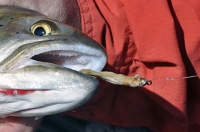
Another technique that works is to fish the fly dead-drift, more like a nymph. This technique works best with a floating line and a weighted fly. I almost always use two tandem flies for this and sometimes I even drop a nymph from my streamer. I’m not crazy about using an indicator for this. Rather I use a high-stick method. Cast the fly upstream and across. Try to keep a tight connection to the fly as it drifts downstream. In order to do that you’ll need to keep lifting the rod as you follow the line downstream. As the line drifts past you’ll need to start lowering the rod tip until it is almost down to the water when the fly hangs directly below your position. Set the hook at the slightest hesitation as you watch the tip of the line.
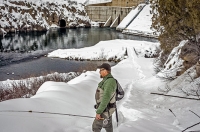
While access can be tough this time of year, fishing streamers from a drift boat can be very exhilarating and effective. Boating accesses will be better later in March. Since the boat is moving you’ll need to strip the line in order to keep the fly moving but don’t strip fast. It’s better to use short casts. You can also use the dead drift method described above. Check out our video entitled “Down and Dirty Streamer Fishing” with Devan Ence, Chris Lawson and Braide Sessions fishing streamers in early March on the Henry’s Fork below St Anthony.
In most cases you won’t hook as many trout as you would if you fish nymphs but chances are the trout will be larger. In fact, some of the biggest trout I’ve caught have succumbed to my streamer. Besides that there is always a serious adrenaline rush when the line pulls tight and you feel the heavy resistance of a big trout. Who can’t use an adrenaline rush? That’s one of the reasons I go fishing.